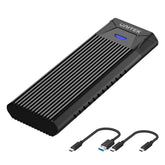
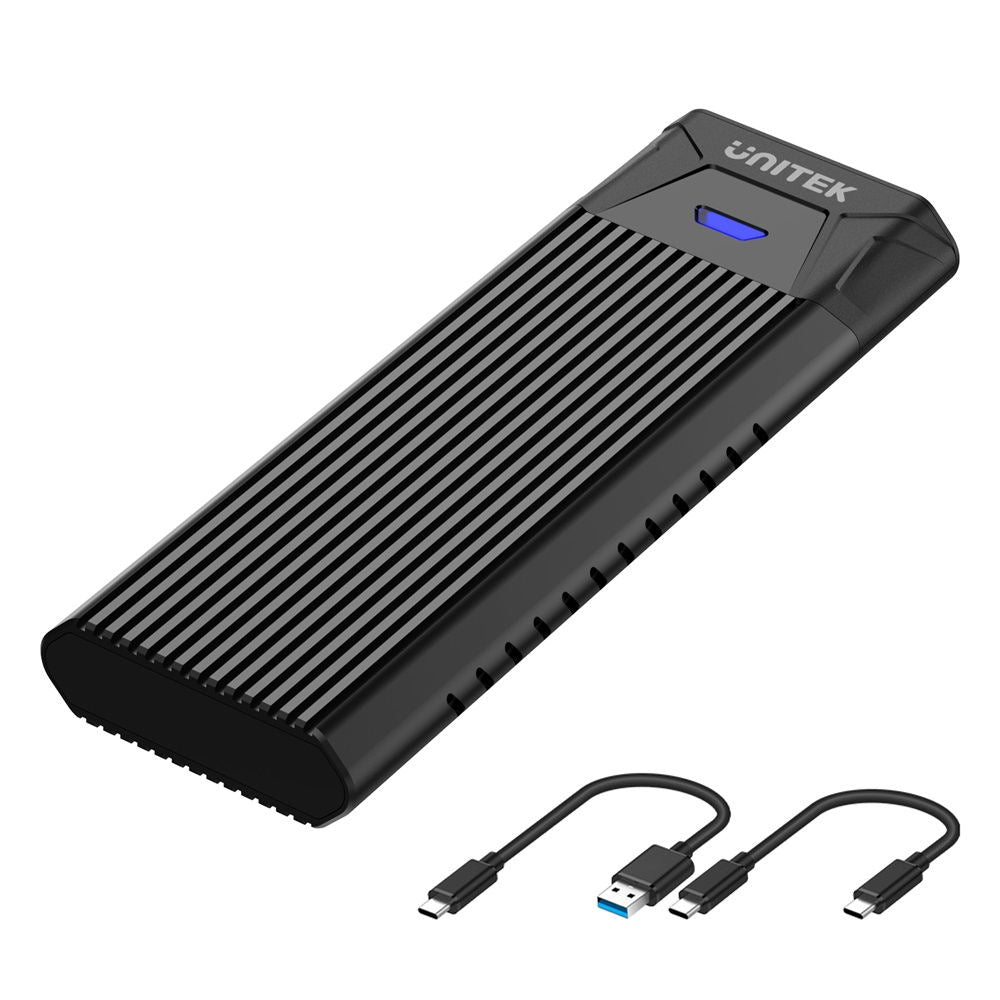
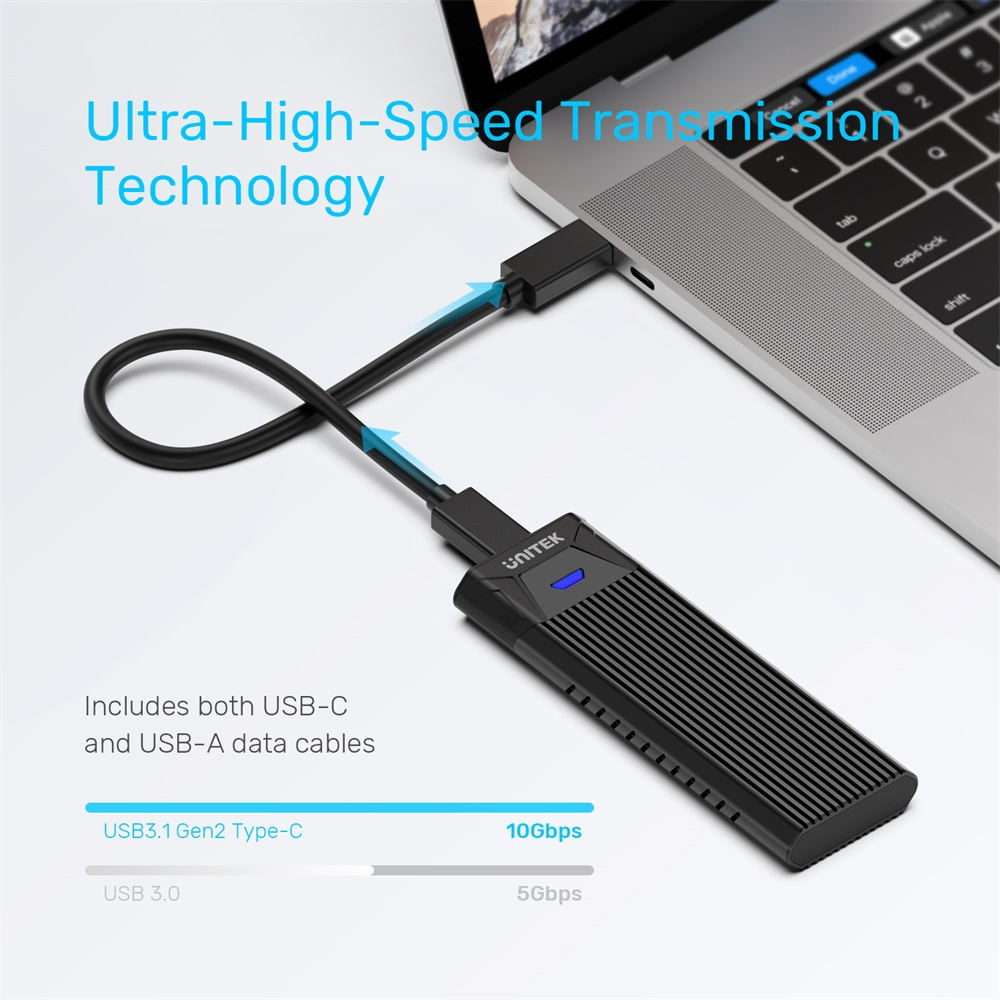
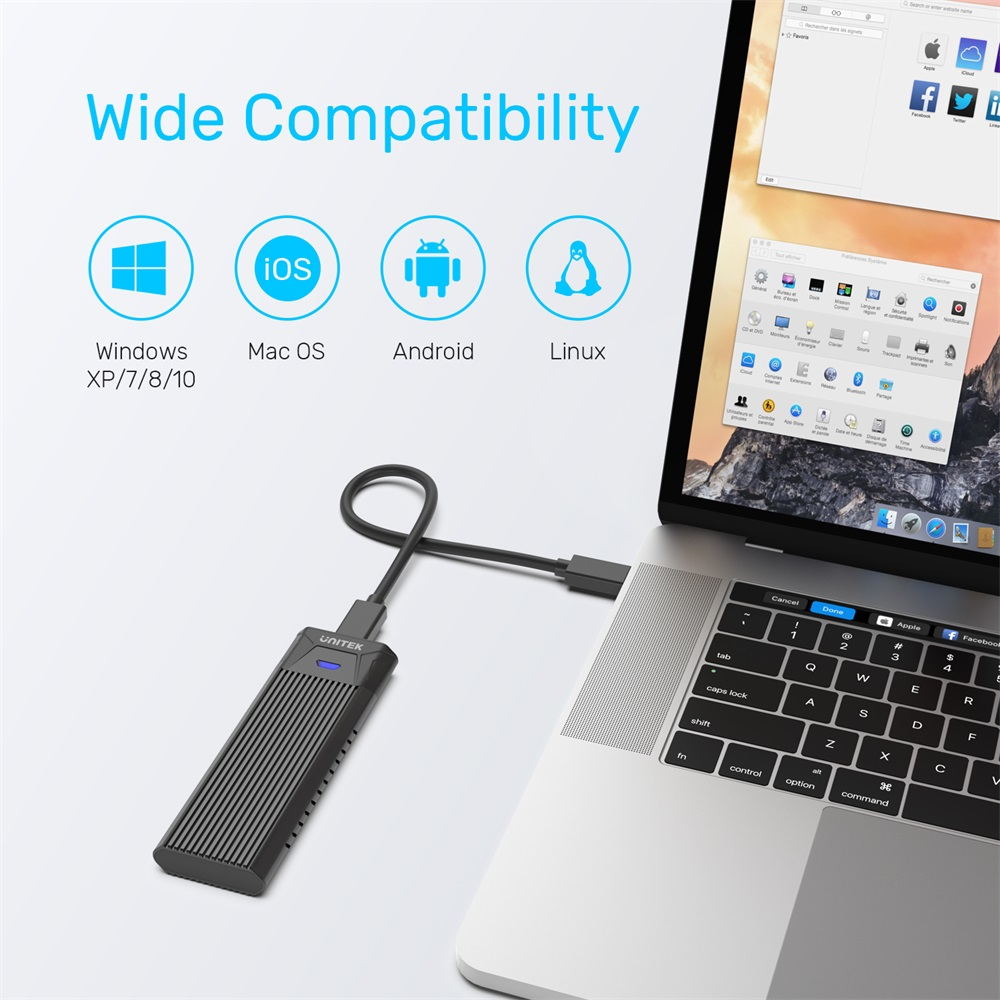
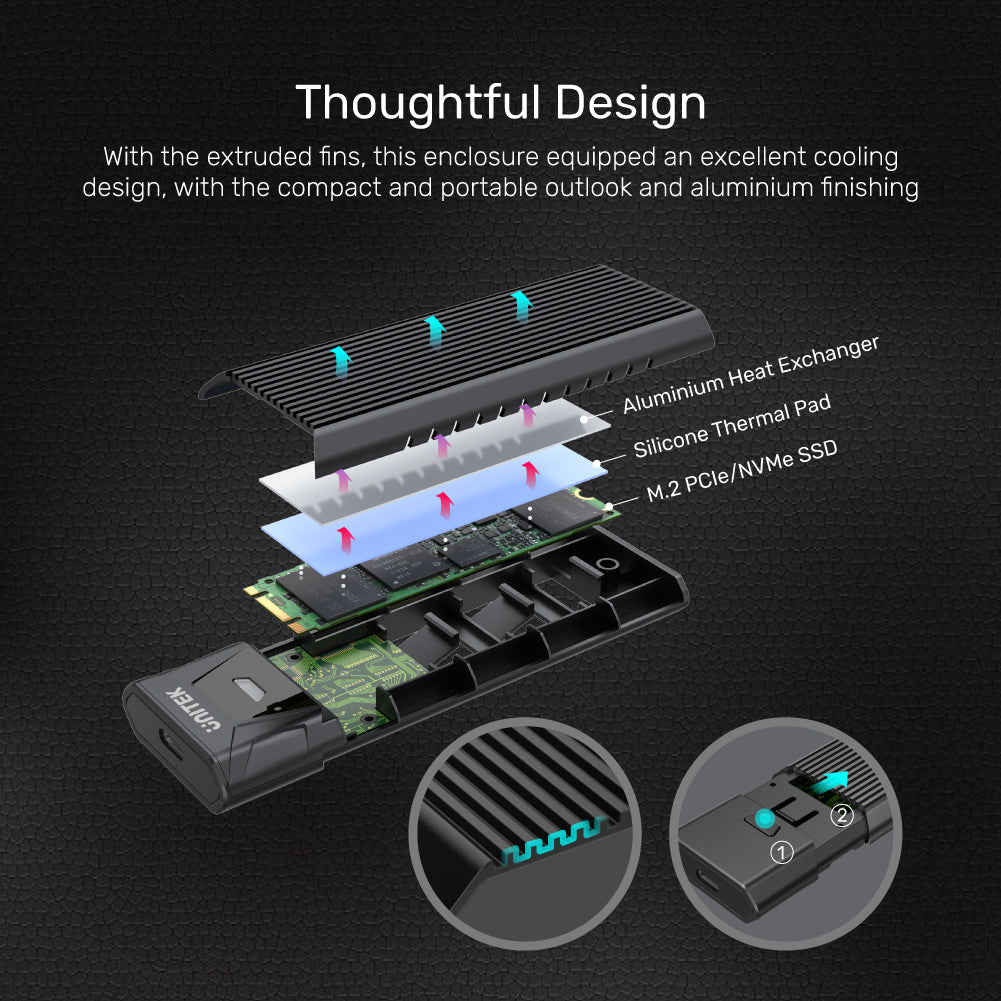
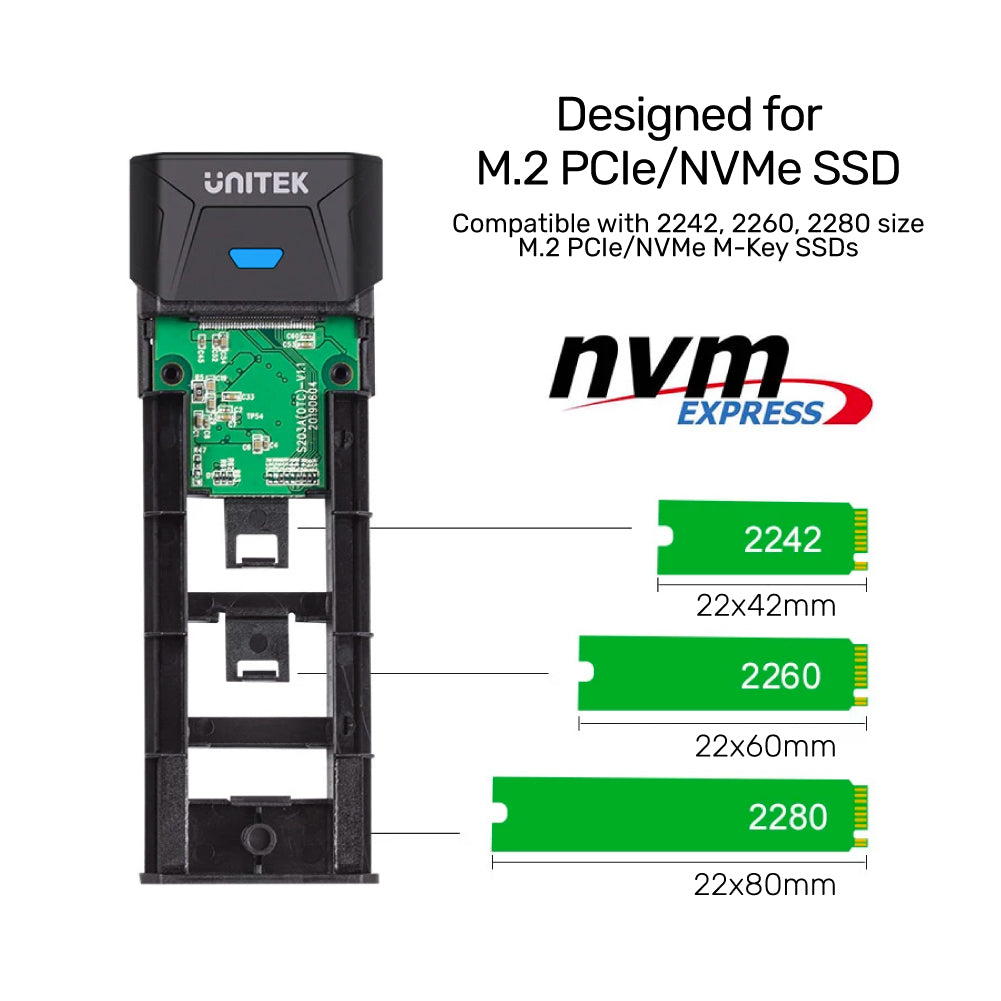
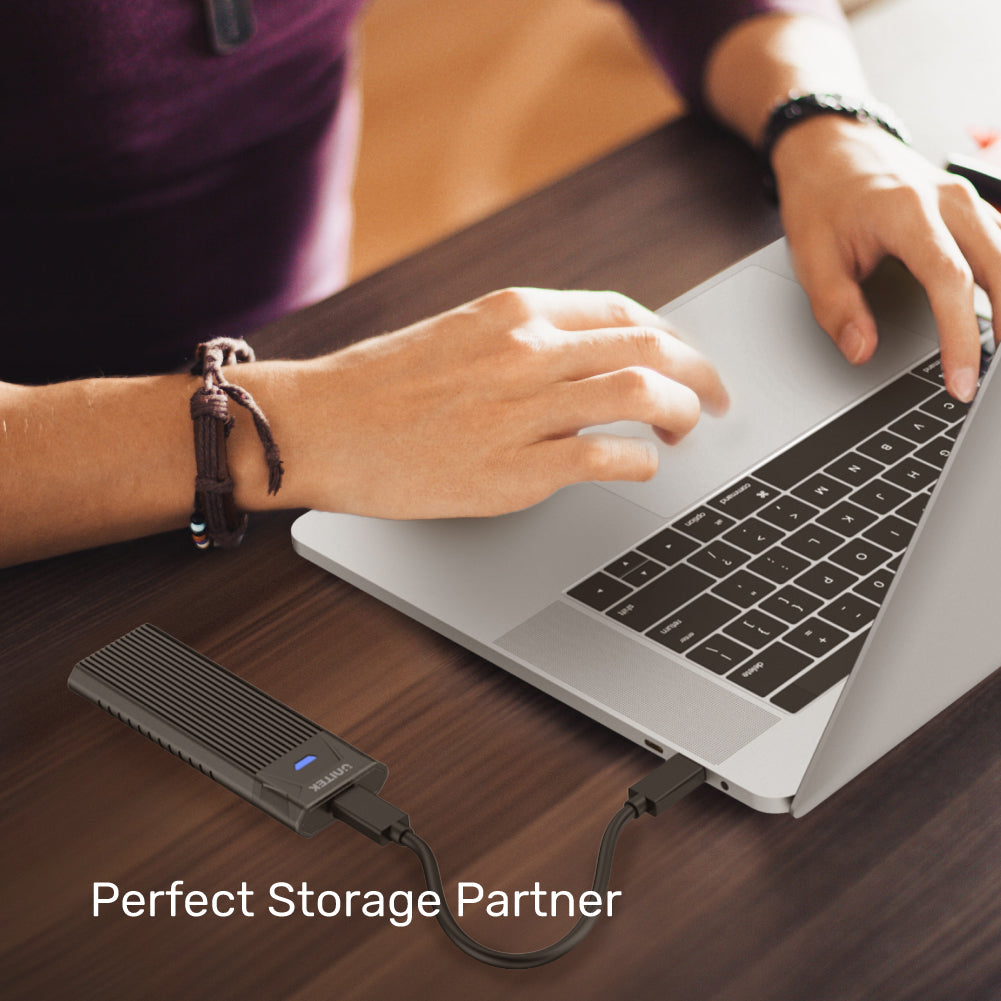
SolidForce PCIe/NVMe M.2 SSD Enclosure Lite
UNITEK SolidForce Enclosure Lite supports all M/ M &B Key NVMe SSDs up to 8TB and PCIe/ NVMe SSD sizes: 42mm/ 60mm/ 80mm. With data transfer speed up to 10Gbps, this enclosure also supports UASP and TRIM to optimize performance and capacity of SSD and enabling it to last longer.
-
10Gbps Transmission Speed: This NVMe M.2 Enclosure adopts USB-C 10Gbps interface 3.1 Gen 2 and it is backward compatible with USB 3.1 GEN 1 and USB 3.0 up to 5Gbps
-
Wide Compatibility: This M.2 SSD Enclosure supports M 2 NVMe M Key SSD with size s in 2230/ 2242/ 2260/ 2280
-
Effective Heat Dissipation: This PCIe/ NVMe enclosure is made of aluminum housing to effectively dissipate the heat and protect your SSD, keeping it at its peak performance
-
Optimize SSD For Best Performance: This enclosure supports UASP and TRIM UASP enables faster data transfer to and from storage devices TRIM can improve write performance, optimize the capacity of SSD and enabling it to last longer
-
Safe and Reliable: This enclosure adopts JMS583 chip with anti breakage and overcurrent protection to keep your precious data safe
-
Tool Free Installation: Tool free design for quick and easy installation of the M.2 PCIe/ NVMe SSDs
-
Compatible Systems: This SSD enclosure is compatible with Windows 7/ 10/ 11, Mac 10.5 or later versions, Linux
*This product do not support M.2 SATA and Any SSDs with Heat Sink
Note: If your hard drive is new, please initialize, partition and format the drive before use.
Please refer to user manual for more details.
-
Dimensions: 117.5mm x 40.0mm x 13.5mm
-
Compatibility: NVMe SSDs
-
Supports SSD Sizes: 2242/ 2260/2280
-
Cable Length: 30cm
-
Transfer Speed: 10Gbps
-
Material/ Color: Aluminium Alloy/ Space Grey
1 x M.2 SSD Enclosure
1 x USB-C to USB-C Data Cable
1 x USB-C to USB-A Data Cable
1 x User Manual
Shipping cost will be calculated during checkout. International duties & taxes may apply and are not calculated at checkout.
Shipping & Delivery
For shipping quotes, "Checkout" the item you want to buy, enter your shipping details and the shipping rates will automatically generate based on the item's weight and the delivery location.
If the shipping rates do not generate, please contact us.
Normal Shipping Times: 3-14 business days
The final shipping days are according to your local because of COVID-19 guidelines.
Delays:
Unitek is not responsible for delays in shipping caused by extraneous factors (such as incorrect addresses, weather, inspections, labor disputes, and/or transportation problems). We cannot be responsible for lost or damaged packages.
Duties & Taxes:
Orders shipped outside of the United States may be subject to import taxes, customs duties, fees, and/or VAT (Value Added Taxes) levied by the destination country. You are responsible for paying any taxes, duties, customs fees, and/or VAT charged by your government, as UNITEK has no control over these charges and cannot predict what they may be. Please contact the local customs office in the relevant jurisdiction for additional information on customs policies or duties. International orders will not be refunded for failure to pay import duties, taxes or fees.
Global Shipping Notes:
For customers in Korea, please fill in your Korean Name (not in English) which must correspond to the Personal Custom Code;
For customers in Taiwan, please fill in the ID number;
For customers in South Africa, please fill in the ID number;
For customers in Chile, please fill in RUT.
For any other questions or inquiries, please contact us.
Shipping & Delivery
For shipping quotes, "Checkout" the item you want to buy, enter your shipping details and the shipping rates will automatically generate based on the item's weight and the delivery location.
If the shipping rates do not generate, please contact us.
Normal Shipping Times: 3-14 business days
The final shipping days are according to your local because of COVID-19 guidelines.
Delays:
Unitek is not responsible for delays in shipping caused by extraneous factors (such as incorrect addresses, weather, inspections, labor disputes, and/or transportation problems). We cannot be responsible for lost or damaged packages.
Duties & Taxes:
Orders shipped outside of the United States may be subject to import taxes, customs duties, fees, and/or VAT (Value Added Taxes) levied by the destination country. You are responsible for paying any taxes, duties, customs fees, and/or VAT charged by your government, as UNITEK has no control over these charges and cannot predict what they may be. Please contact the local customs office in the relevant jurisdiction for additional information on customs policies or duties. International orders will not be refunded for failure to pay import duties, taxes or fees.
Global Shipping Notes:
For customers in Korea, please fill in your Korean Name (not in English) which must correspond to the Personal Custom Code;
For customers in Taiwan, please fill in the ID number;
For customers in South Africa, please fill in the ID number;
For customers in Chile, please fill in RUT.
For any other questions or inquiries, please contact us.

Tool-Free design allows quick and easy installation of your M.2 NVMe SSDs. Plug and play, no drivers needed. If your hard drive is new, please initialize, partition and format the drive before use.

This PCIe/ NVMe enclosure is made of aluminum housing, slim design, durable and excellent heat dissipation, reduced power consumption. Supports UASP/ TRIM with ultra-fast transmission speed.

This M.2 SSD Enclosure supports M.2 NVMe M Key SSD with size s in 2230/ 2242/ 2260/ 2280.
Windows 10
Before you can access a new or formatted drive in your operating system, you need to initialize it first and then create a partition on the drive. A partition defines an area of the drive to use for storing data. The partition uses a file system (for example, ex-FAT, NTFS, and so on).
Initialize a drive
Note: You typically only need to initialize a drive if the drive is new. If you cannot find an uninitialized drive in Disk Management, skip the following steps and try to partition your device.
Press the Windows key + R, type compmgmt.msc, and click Run to open Computer Management.
Navigate to Disk Management.
When prompted to, initialize your disk(s). If you are running Windows® 7 or later and are using a drive larger than 2TB, initialize the disk(s) with GPT. If you are running an earlier version of Windows, initialize the disk(s) with MBR. For more information, visit the following FAQ: https://www.startech.com/support/faqs/technical-support?topic=hard-drives#mbr-vs-gpt.
Click OK.
Create a partition in a drive
Note: The following steps create an NTFS partition that uses the entire drive space. To use a different file system, select a different option in step 6.
Right-click Unallocated or RAW volume, and select New Simple Volume.
In the New Partition Wizard, click Next.
Select Primary partition.
Leave the partition size set to default, and click Next.
Assign a drive letter or leave it set to the default, and click Next.
Enter the following settings to format the partition:
In the File System field, enter NTFS.
Set the Allocation unit size to Default.
In the Volume label field, enter <your name/reference>.
Select the Perform a quick format check box.
Clear the Enable file and folder compression check box.
Click Next > Finish.
The new drive should appear in Windows Explorer.
Mac OS
Before you can access a new or formatted drive in your operating system, you need to initialize it first and then create a partition on the drive. A partition defines an area of the drive to use for storing data. The partition uses a file system (for example, HFS+, ex-FAT, NTFS, and so on).
Initialize a drive
Mac OSX detects a drive that needs to be initialized and automatically prompts you to initialize the drive. If you are prompted to initialize the drive, click Initialize. If you are not prompted to initialize the drive and you cannot find the drive in Finder, you will need to create a partition on the drive.
Create a partition on a drive
Note: The following steps create an HFS+ (Mac OS Extended (Journaled)) partition that uses the entire drive space.
To create a partition on a new drive, complete the following:
Open Finder.
Navigate to Applications and click Utilities.
Open Disk Utility.
Select the new drive and click the Partition tab.
Click Options and verify that it is set to GUID Partition Table.
Enter a name for the partition.
Click Partition.
The drive should now be accessible in Finder.
The drive may be damaged. Test with a known-working drive, or test the drive directly to a PC.
The operating system on the computer may not support reading and writing to the file system on the docked hard drive or SSD. Remember, Windows cannot read Mac or Linux file systems. Also, macOS can read but not write to NTFS drives.
If the drives came from a RAID (Redundant Array of Independent Disks), they would not be accessible in our docking stations.
If the drive uses 4Kn sectors, check the technical specifications of the docking station, and ensure it can read 4Kn drives.
You do not need to format your target hard drive before you begin to duplicate it, because the target hard drive is automatically overwritten during the duplication process.
